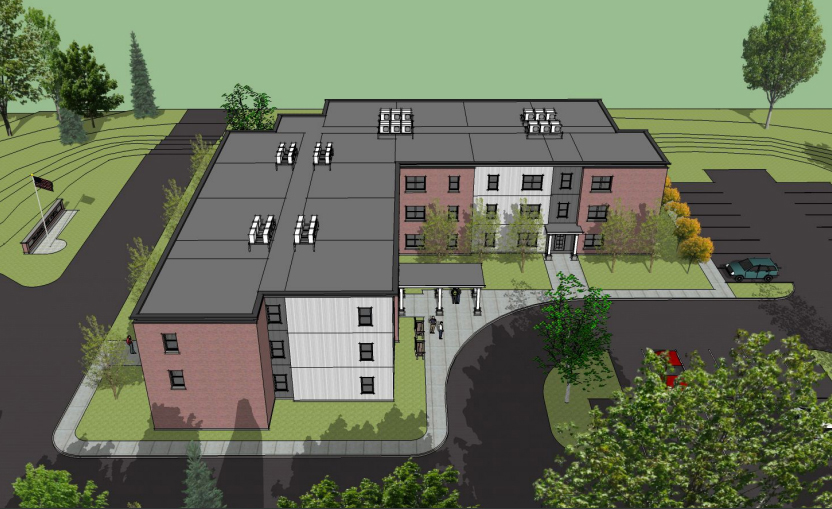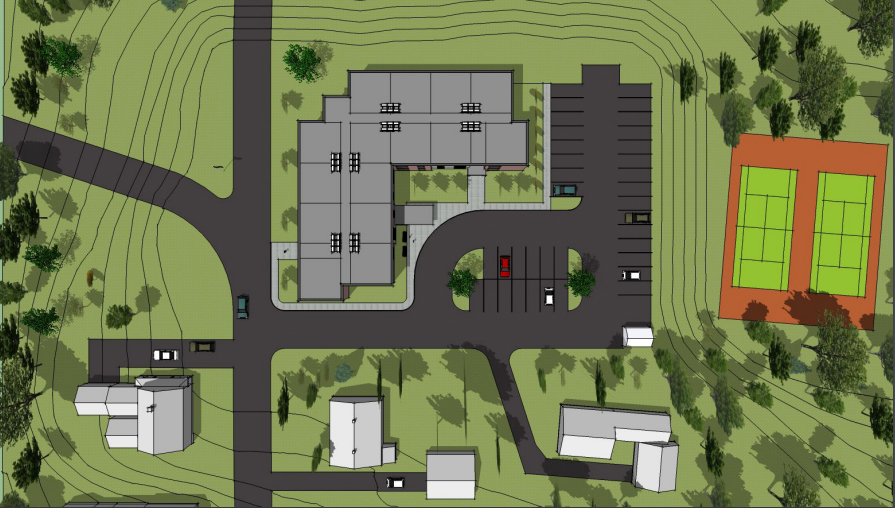
Draft designs for a new 36-unit affordable senior housing development by Volunteers of America on the former A.D. Gray school site in Waldoboro feature a flat roof to hide heat pumps for each unit and keep options open for solar panel use. Architect Robert Foster said the flat roof also saves height on the three-story building. (Courtesy photo)
Representatives from Volunteers of America Northern New England presented a draft for a 36-unit affordable senior housing development it hopes to build at A.D. Gray School property during the Waldoboro Planning Board meeting on Thursday, Jan. 26.
No motions were made during the meeting. The presenters asked for public and board input at the meeting before they develop a final application to send the board.
Brian Sites, vice president of business development for Volunteers of America, and Travis Drake, the organization’s vice president of housing, attended virtually. Both have worked with the town on the redevelopment in its various forms since 2020 through three referendum votes and a change in plans after the structure was found unstable.
Norm Chamberlain, an engineer from Westbrook-based Walsh Engineering, and Robert Foster, an independent architect, presented their sketch plan to the board via Zoom.
That plan is another step in nearly three years’ work on the project between the town and Volunteers of America. The sale of the site was approved by Waldoboro voters in June, but is still in negotiations.
The school, built in 1935 and vacant since 2009, went on the market in 2011. Volunteers of America first proposed converting the building, but a structural assessment in 2021 found the building’s brick façade is unstable, along with other structural problems.
The building also has mold and asbestos, which Foster said would likely be remediated before demolition.
Throughout the three referendum votes and various plans made since 2020, Sites said, the organization’s goal remains the same.
“Our intent is still to develop those 32-36 units of affordable senior housing in a way that is both attractive to the neighborhood, feels like it is part of the community, adheres to all of the historical standards that have been set in the historic district, and … having the community play a part of the process with feedback and input,” Sites said.
While applications cannot be restricted to residents of Waldoboro and will be processed on a first-come, first-serve basis, board members said similar projects in nearby towns have only two or three residents who lived more than 12-15 miles away before moving in.
Sites said Volunteers of America will use input from the meeting to develop a full application, and no ideas presented Thursday were locked in yet.
“We want to be good neighbors from the outset,” Sites said.
Once more progress is made on the predevelopment plans, Volunteers of America will be competitive for state and federal funding to complete the project. The organization does not have funds of its own for the project and will not receive money from the town, according to Sites.
Foster said fitting the proposed 32,000 square-foot, 36-unit building and 33 parking spaces on the one-acre lot was an ambitious effort, and several options were considered.
The draft he presented doubles the building footprint in an L-shaped structure stretching three stories within the 42-foot height limit in the district.
Foster said a primary goal was to minimize the visual impact from the street. To that end, his design moved the building back 15 more feet and placed 33 parking spaces on the side, rather than in front.

A draft design of the front of an affordable senior housing development at the A.D. Gray school site features vertical sections of brick and wood cladding, which architect Robert Foster said was designed to break up the visual impact from the street. Some residents said they felt the design was not historical enough, but the towns Historic Village District ordinance does not tightly guide new building design. (Courtesy photo)
A flat roof was chosen over a sloped one to house heat pumps for every individual unit and keep the possibility of solar panels open in the future. Both the pumps and potential solar panels would be out of sight if placed on the roof.
Foster said this decision also reduces the height impression from the street.
The building itself features alternating vertical facades of brick and lighter wood cladding. This design was intended to break up the front and resemble separate buildings, like row houses, according to Foster.
In a historical nod, the original “Waldoboro High School” sign is turned into a small monument, which Foster said would use bricks from the original school.
“Our goal is not to make a copy, but to be sensitive to the context,” Foster said of the design’s historic elements.
Response from the board and the audience focused on concerns about the historic elements of the design and traffic flow from the project.
All remarks on the design said that it did not look historic, and several took issue with the vertical lines.
“The architecture is not immediately pleasing,” resident Laura Marqus said. In an email, resident Nancy Van Buren called the design a “modern, institutional structure.”
“I look at this and I don’t see 19th century,” board Chair Brendan McGuirl said.
Board member Barbara Boardman said Waldoboro does not have detailed architectural standards for the historic district in its land use ordinance, meaning the board is limited in the requirements it can set for what the building looks like.
The building’s location was rezoned from the village district to the historic village district in 2020.
According to the land use ordinance’s guidance for that district, “contemporary design for alterations and additions to existing properties shall not be discouraged when such alterations and additions do not destroy significant historical, architectural, or cultural material, and such design is compatible with the scale and character of the property, neighborhood, or environment.”
McGuirl also said too much pushback on the building’s exterior could cause problems for Volunteers of America.
“You have to make those numbers work, and piling on architectural details will affect the viability of the project,” McGuirl said to the presenters.
Resident Cynthia Coner and Boardman both said another design with horizontal design patterns, which Foster said Volunteers of America had decided against, might minimize the height appearance of the construction and “soften” the impression.
“They’re all conceptual at this point,” Foster said.
Lorraine Rosseel, a neighbor to the site, said she was concerned about traffic off of Main and School streets. Several other audience members made similar comments about illegal on-street parking already taking place and traffic levels they find unsafe.
Boardman said the town’s comprehensive plan guides denser development in the village area.
“It’s not rural, it’s a town, and most people want to see activity, and jobs,” as long as it is safe, Boardman said.
She said additional lights or stop signs in town might be helpful, and encouraged residents to circulate a petition if they were concerned about existing traffic problems.

Boardman also said the street did handle traffic when the school was operating, and that 36 residents of the building would not all be driving in and out every day. She said some probably would not have their own car and many might carpool.
Marqus said she and her husband were concerned about construction traffic and noise as well.
“Traffic is an inevitable part of the construction process,” McGuirl said, but steps could be taken to keep construction vehicles off of the street.
Part of a formal application would include limits to construction hours. Town ordinances designate 6:30 a.m. to 8 p.m. Max Johnstone, the town’s planning and development director, said the planning board can restrict those hours further.
Boardman asked if the parking lot design would restrict access to the tennis courts next to the school. The town will retain ownership of that acre.
Sites said Volunteers of America does not want to be responsible for the unusable courts due to liability concerns, but would work to provide access to them once the town knows what it plans to do with them.
Concerns about stormwater drainage would be mitigated by a level spreader trench and follow the existing swales on the site, Chamberlain said, and these plans “will eliminate most of the runoff that happens today.”
Ben Vail, an abutter of the property and the principal of A.D. Gray when it closed in 2009, said several other steps could increase the historic value. He suggested incorporating the entryway arch design of the existing building and rescuing a plaque currently inside for display on the new property. Vail also said he appreciated the design.
“Any negative from it being 5 feet taller is totally outweighed to me by having a beautiful new building instead of a building that’s become derelict for 15 years. I’m greatly looking forward to the new neighbors,” Vail said.
Sites said Volunteers of America will develop a formal application with board and public comments in mind. Volunteers of America hopes to have that application before the planning board for approval and begin applying for funding in the spring, Sites said.
Designs and documents from the pre-application are available through the planning board’s page on the town website at waldoboromaine.org.
The Waldoboro Planning Board will next meet at 6 p.m. on Thursday, Feb. 9 in the town office and by Zoom.






